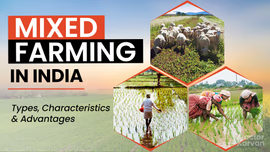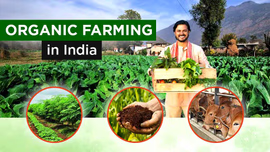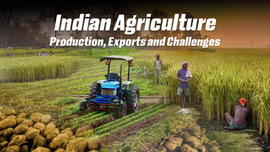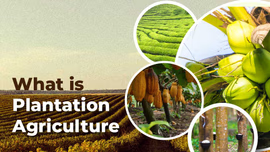Contour Farming in India: Shaping the Land with Contours

Contour Farming is a very common farming technique practiced in India. It is commonly practiced in hilly regions having bund or ridges. It helps to promote crop yield and reduces soil erosion. In this blog, we will understand the brief context of contour farming in India.
Table of Contents
- What is Contour Farming?
- A Brief Context of Contour Farming in India
- Benefits of Contour Farming
- Crops grown through Contour Cultivation
- Contour Strip Cropping
- Preparation of Land for Contour Farming (Ploughing)
- Limitations of Contour Farming
What is Contour Farming?
Contour farming is the method of planting crops along a contour that is basically across the slope (horizontal) rather than up and down (vertical). Furrows are ploughed perpendicular rather than parallel to the slope. Usually, there is a confusion between contour farming and terrace farming, but both techniques are different form each other. Contour farming is recommended for lands with the slope range of 2% to 7%. In contour farming, the natural shape of the slope is followed without altering it, whereas terrace farming alters the shape of the slope and build walls making the flat surfaces for the water catchment and to check soil erosion. Now, Let’s understand the brief context of contour farming in India.
A Brief Context of Contour Farming in India
Contour farming is a traditional and very common farming technique followed in India. Contour farming is practiced under different agroecological conditions. Basically, it is a strategy to preserve the rainwater. It is used in the hills across all climatic zones or regions which have <5° slope receiving <500 mm annual rainfall, bunding or contour cultivation are used, and conservative furrows are used in <500-700 mm annual rainfall. The effectiveness of the practice depends upon the area’s rainfall intensity, topography and types of soil. The contour farming helps in crop management, increase crop yield, decreases soil erosion, fertilizer cost and the production cost. Assam is ideal for contour farming in India, as it receives heavy rainfall and has a system of plantation cultivation.
Contour farming is considered as one of the important mitigation techniques for reversing land degradation in hilly areas; Indo-Gangetic plains; dryland and desert areas; southern peninsular India; central India and coastal areas. Contour bunding /trenching is one of the rainfall management strategies in the Integrated Watershed Management Programme of Pradhan Mantri Krishi Sinchaayi Yoajana (PMKSY).
Benefits of Contour Farming
There are several benefits of contour farming. These includes:
- Reduces soil erosion by as much as 50%
- Lower fertilizer costs
- Soil and water conservation such as strip cropping
- Better water quality
- Efficient irrigation
- Reduces the risk of land degradation
Crops grown through Contour Cultivation
In contour farming, almost all kind of crops can be grown depending upon the climate, temperature, topography and locational factors. But only few of them are commonly grown. Here is the list of commonly grown crops through contour farming:
- Corn
- Paddy
- Grass
- Soyabeans
- Legumes
- Cardamom
Contour Strip Cropping
Growing of equal widths of alternating crops along the natural contours of a sloping land is known as contour strip cropping. Some of the benefits include:
- It helps in reducing soil erosion and runoff more than contour farming.
- With alternating crops, contour strip cropping requires an adjustment to scheduling field operations.
- Planting rotational crops in strips, such as grain corn and soybeans can encourage eroded soil to settle out at the boundaries of these different cropping zones. This reduces the chance of sediment loss moving beyond the field edge.
- Overall, the strip cropping is beneficial in retaining soil moisture and increases soil fertility.
Preparation of Land for Contour Farming (Ploughing)
Preparing the land for contour farming is a crucial step as the movement of the water can damage your crops. The contour slopes accelerate the water flow, and the speed of the flowing water can wash away the soil resulting in the damage of the crops.
Follow the below steps to prepare the land for contour farming:
- Conduct the typographic survey of the field carefully.
- Construct field borders for the proper movement of the farm equipment and machinery.
- Carry out farming activities parallel to the contour baseline.
Limitations of Contour Farming
With benefits, there are also some limitations of contour farming. Let’s have a look on some limitation below:
- Limited Applicability- Contour farming is suitable only for sloping areas with gradients between 2% and 10%. Flat or excessively steep areas may not be feasible or effective for contour farming.
- Labour-intensive Implementation- Due to the contour lines and slopes, it takes more than usual time hence it is labour-intensive implementation method.
- Limited Crop Choices- There is always a limitation of the crop choices due to the sloping field area. So, this method limits the diversity of the crops which farmers can grow.
- Maintenance Requirements- Contour rows, terraces, and structures require regular maintenance to ensure effective erosion control. This maintenance can be demanding and time-consuming for farmers.
- Initial Investment- This method requires a heavy initial investment which turns out to be a financial burden for the small-scale farmers.
Contour farming is an efficient cost-effective farming method used in India that helps in retaining soil moisture and gives an output of huge yield productivity and soil conservation. Hence, it is a sustainable method that reduces soil erosion by 50%.
Frequently Asked Questions On Contour Farming in India: Shaping the Land with Contours
1. What is contour farming?
Contour farming is the method of planting crops along a contour that is basically across the slope (horizontal) rather than up and down (vertical).
2. How does contour farming prevent soil erosion?
Contour farming helps prevent water runoff while keeping soil moisture levels in balance results in preventing soil erosion.
3. Where is contour farming used?
Contour farming is best suitable for the lands with slope range of 2% to 7%.
4. Where is contour farming performed in India?
Assam, Meghalaya, Himachal Pradesh and Uttarakhand are the best examples where most of the contour farming takes place.


Related Blogs












